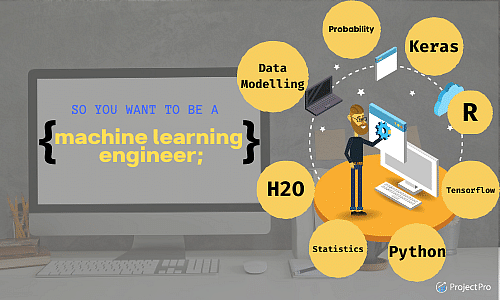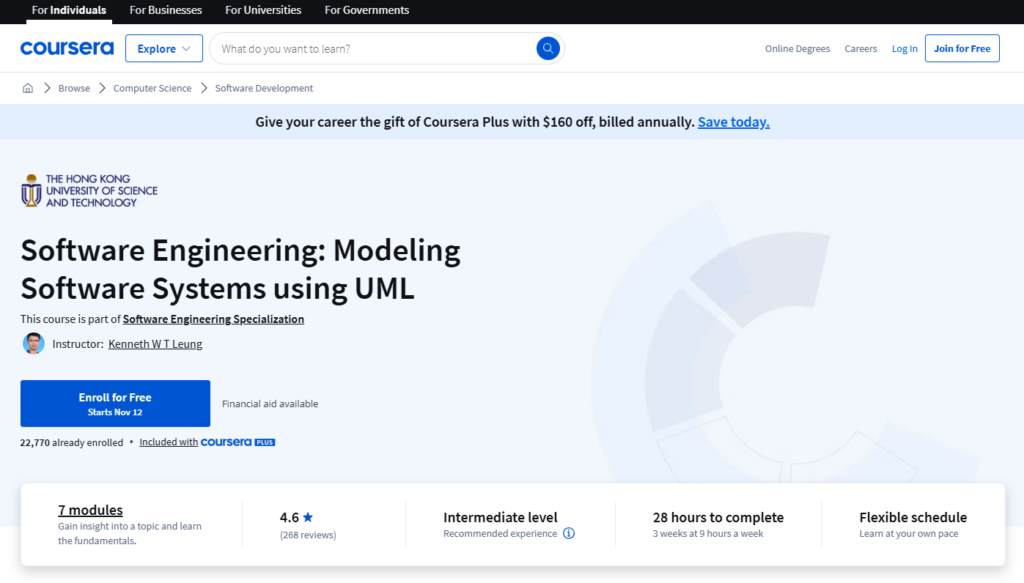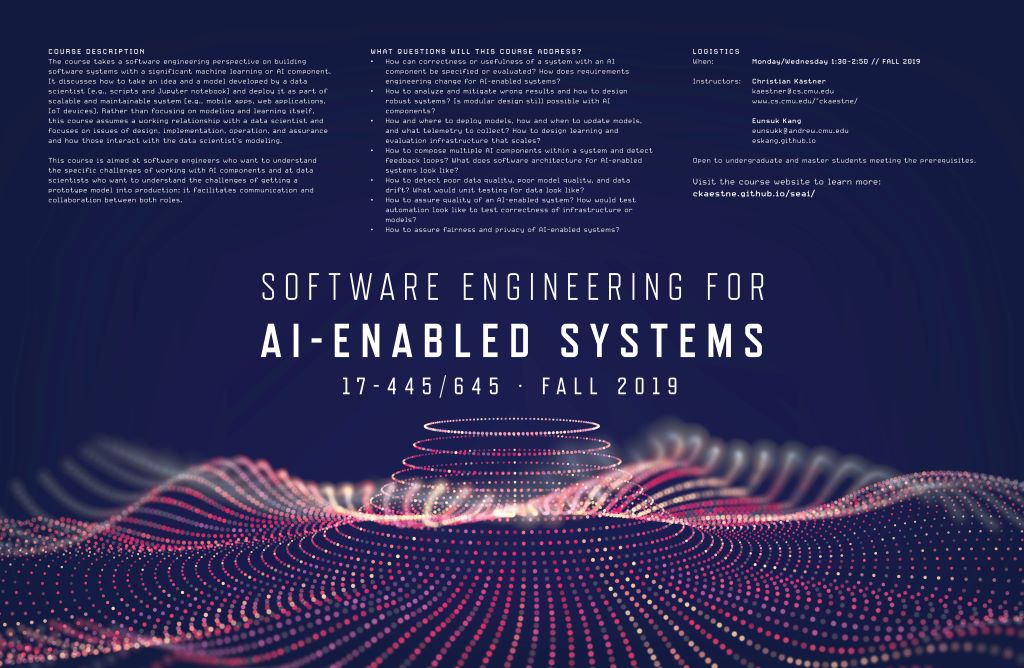All Categories
Featured
Table of Contents
- – Some Ideas on Interview Kickstart Launches Bes...
- – What Is A Machine Learning Engineer (Ml Engine...
- – Best Machine Learning Courses & Certificates ...
- – The 10-Minute Rule for Top 20 Machine Learnin...
- – Machine Learning (Ml) & Artificial Intellige...
- – How I Went From Software Development To Mach...
- – The 25-Second Trick For What Does A Machine ...
Some people assume that that's unfaithful. Well, that's my whole profession. If somebody else did it, I'm mosting likely to use what that individual did. The lesson is placing that apart. I'm forcing myself to analyze the possible solutions. It's more concerning consuming the material and trying to apply those concepts and less concerning discovering a collection that does the job or searching for someone else that coded it.
Dig a little bit deeper in the math at the beginning, so I can build that foundation. Santiago: Ultimately, lesson number seven. This is a quote. It says "You need to comprehend every detail of an algorithm if you wish to utilize it." And then I claim, "I think this is bullshit suggestions." I do not believe that you need to recognize the nuts and screws of every algorithm before you use it.
I have actually been using semantic networks for the longest time. I do have a sense of exactly how the slope descent functions. I can not describe it to you now. I would certainly need to go and inspect back to in fact obtain a much better intuition. That doesn't imply that I can not address points using neural networks? (29:05) Santiago: Attempting to compel people to believe "Well, you're not mosting likely to succeed unless you can discuss each and every single information of just how this works." It returns to our sorting instance I assume that's simply bullshit advice.
As an engineer, I have actually dealt with several, lots of systems and I have actually utilized several, numerous points that I do not understand the nuts and bolts of exactly how it works, although I comprehend the effect that they have. That's the last lesson on that string. Alexey: The amusing thing is when I assume regarding all these libraries like Scikit-Learn the algorithms they make use of inside to execute, as an example, logistic regression or something else, are not the exact same as the algorithms we examine in machine understanding courses.
Some Ideas on Interview Kickstart Launches Best New Ml Engineer Course You Should Know
Also if we attempted to find out to get all these basics of device understanding, at the end, the formulas that these libraries make use of are various. ? (30:22) Santiago: Yeah, definitely. I think we require a whole lot more pragmatism in the market. Make a great deal more of an impact. Or concentrating on providing value and a little bit less of purism.

Incidentally, there are two various courses. I typically speak with those that wish to work in the sector that wish to have their impact there. There is a path for scientists which is completely different. I do not dare to mention that due to the fact that I don't understand.
Right there outside, in the market, pragmatism goes a long way for sure. Santiago: There you go, yeah. Alexey: It is an excellent motivational speech.
What Is A Machine Learning Engineer (Ml Engineer)? Fundamentals Explained
One of the points I desired to ask you. Initially, allow's cover a couple of things. Alexey: Allow's begin with core devices and frameworks that you need to learn to actually change.
I recognize Java. I understand just how to use Git. Perhaps I understand Docker.
What are the core devices and frameworks that I require to find out to do this? (33:10) Santiago: Yeah, absolutely. Terrific question. I assume, primary, you need to start learning a bit of Python. Since you already understand Java, I do not believe it's going to be a substantial shift for you.
Not since Python is the same as Java, yet in a week, you're gon na get a whole lot of the differences there. Santiago: After that you get particular core tools that are going to be utilized throughout your whole job.
Best Machine Learning Courses & Certificates [2025] Things To Know Before You Buy
You get SciKit Learn for the collection of maker understanding formulas. Those are tools that you're going to have to be using. I do not recommend simply going and finding out concerning them out of the blue.
We can discuss details training courses later on. Take among those courses that are going to begin presenting you to some issues and to some core concepts of artificial intelligence. Santiago: There is a course in Kaggle which is an introduction. I do not keep in mind the name, however if you most likely to Kaggle, they have tutorials there completely free.
What's excellent about it is that the only need for you is to recognize Python. They're mosting likely to provide a problem and inform you just how to make use of choice trees to address that details problem. I believe that procedure is exceptionally effective, due to the fact that you go from no device finding out background, to understanding what the trouble is and why you can not address it with what you recognize today, which is straight software engineering practices.
The 10-Minute Rule for Top 20 Machine Learning Bootcamps [+ Selection Guide]
On the various other hand, ML designers specialize in structure and releasing device learning designs. They concentrate on training models with information to make forecasts or automate jobs. While there is overlap, AI engineers handle more varied AI applications, while ML designers have a narrower emphasis on artificial intelligence formulas and their functional implementation.

Device discovering engineers focus on creating and releasing device knowing versions right into manufacturing systems. On the other hand, information scientists have a wider function that consists of data collection, cleaning, expedition, and building designs.
As companies increasingly adopt AI and device discovering technologies, the demand for knowledgeable experts grows. Maker understanding engineers work on sophisticated projects, add to innovation, and have affordable incomes.
ML is fundamentally different from traditional software program advancement as it concentrates on training computer systems to gain from data, instead than programming explicit regulations that are carried out methodically. Unpredictability of outcomes: You are probably utilized to creating code with foreseeable outputs, whether your feature runs when or a thousand times. In ML, nonetheless, the end results are less specific.

Pre-training and fine-tuning: Just how these designs are educated on huge datasets and afterwards fine-tuned for specific jobs. Applications of LLMs: Such as message generation, belief evaluation and details search and access. Papers like "Interest is All You Need" by Vaswani et al., which introduced transformers. On the internet tutorials and programs concentrating on NLP and transformers, such as the Hugging Face program on transformers.
Machine Learning (Ml) & Artificial Intelligence (Ai) - Truths
The ability to handle codebases, combine changes, and fix problems is simply as crucial in ML growth as it remains in typical software program jobs. The skills established in debugging and testing software applications are highly transferable. While the context might transform from debugging application reasoning to determining issues in information processing or design training the underlying principles of organized investigation, theory screening, and iterative improvement are the same.
Maker understanding, at its core, is greatly reliant on statistics and likelihood concept. These are critical for comprehending exactly how formulas find out from data, make predictions, and review their performance. You must consider ending up being comfortable with principles like statistical importance, circulations, theory testing, and Bayesian thinking in order to design and translate versions properly.
For those curious about LLMs, a thorough understanding of deep understanding styles is beneficial. This consists of not just the mechanics of neural networks yet additionally the style of details designs for different use instances, like CNNs (Convolutional Neural Networks) for photo handling and RNNs (Recurrent Neural Networks) and transformers for sequential information and all-natural language handling.
You must understand these concerns and find out strategies for identifying, reducing, and communicating regarding predisposition in ML designs. This consists of the potential effect of automated decisions and the moral ramifications. Several versions, particularly LLMs, require substantial computational sources that are often provided by cloud platforms like AWS, Google Cloud, and Azure.
Building these skills will not just promote a successful transition into ML yet additionally make sure that developers can contribute efficiently and sensibly to the improvement of this vibrant field. Concept is necessary, but nothing beats hands-on experience. Begin working with projects that allow you to apply what you have actually found out in a sensible context.
Participate in competitions: Sign up with platforms like Kaggle to join NLP competitions. Build your projects: Start with simple applications, such as a chatbot or a message summarization tool, and progressively raise complexity. The field of ML and LLMs is swiftly advancing, with brand-new innovations and modern technologies emerging consistently. Staying updated with the current research and fads is crucial.
How I Went From Software Development To Machine ... Things To Know Before You Buy
Contribute to open-source tasks or compose blog messages concerning your knowing trip and tasks. As you gain knowledge, start looking for chances to incorporate ML and LLMs right into your work, or look for new duties concentrated on these innovations.

Possible use instances in interactive software, such as suggestion systems and automated decision-making. Recognizing uncertainty, fundamental analytical steps, and likelihood circulations. Vectors, matrices, and their duty in ML formulas. Error minimization techniques and slope descent described simply. Terms like model, dataset, features, tags, training, inference, and validation. Data collection, preprocessing methods, version training, evaluation procedures, and deployment factors to consider.
Choice Trees and Random Forests: User-friendly and interpretable designs. Support Vector Machines: Optimum margin category. Matching trouble types with suitable versions. Balancing performance and complexity. Standard framework of semantic networks: nerve cells, layers, activation functions. Layered calculation and ahead proliferation. Feedforward Networks, Convolutional Neural Networks (CNNs), Recurrent Neural Networks (RNNs). Picture acknowledgment, series forecast, and time-series analysis.
Continuous Integration/Continuous Release (CI/CD) for ML process. Design monitoring, versioning, and efficiency tracking. Identifying and attending to adjustments in version performance over time.
The 25-Second Trick For What Does A Machine Learning Engineer Do?

Course OverviewMachine understanding is the future for the future generation of software experts. This training course works as an overview to artificial intelligence for software engineers. You'll be presented to three of the most appropriate parts of the AI/ML self-control; monitored learning, semantic networks, and deep understanding. You'll realize the distinctions in between conventional shows and artificial intelligence by hands-on advancement in monitored understanding prior to developing out complex distributed applications with semantic networks.
This program works as a guide to device lear ... Show A lot more.
Table of Contents
- – Some Ideas on Interview Kickstart Launches Bes...
- – What Is A Machine Learning Engineer (Ml Engine...
- – Best Machine Learning Courses & Certificates ...
- – The 10-Minute Rule for Top 20 Machine Learnin...
- – Machine Learning (Ml) & Artificial Intellige...
- – How I Went From Software Development To Mach...
- – The 25-Second Trick For What Does A Machine ...
Latest Posts
How To Prepare For A Software Engineering Whiteboard Interview
How To Crack The Machine Learning Engineer Interview
The 3-month Coding Interview Preparation Bootcamp – Is It Worth It?
More
Latest Posts
How To Prepare For A Software Engineering Whiteboard Interview
How To Crack The Machine Learning Engineer Interview
The 3-month Coding Interview Preparation Bootcamp – Is It Worth It?